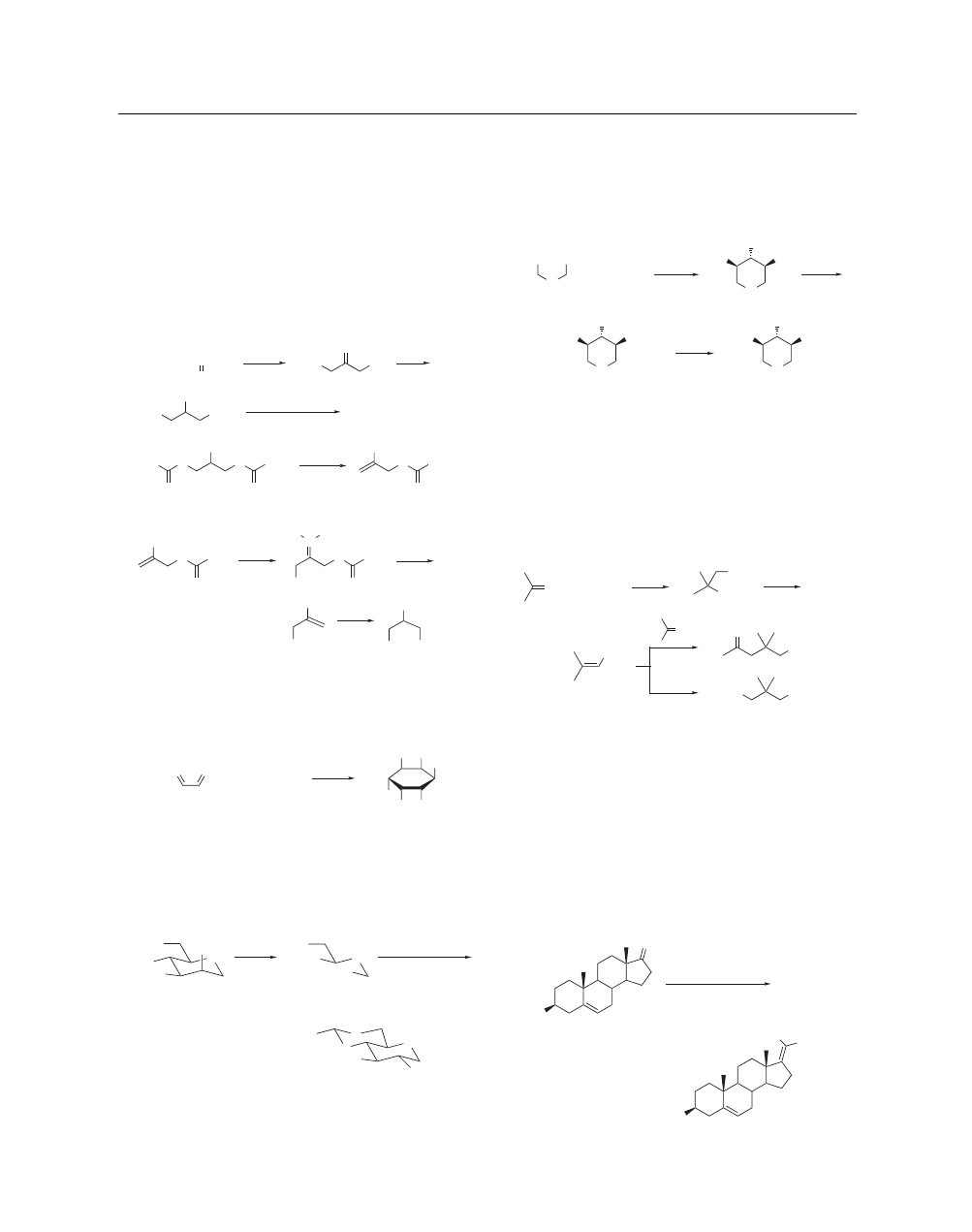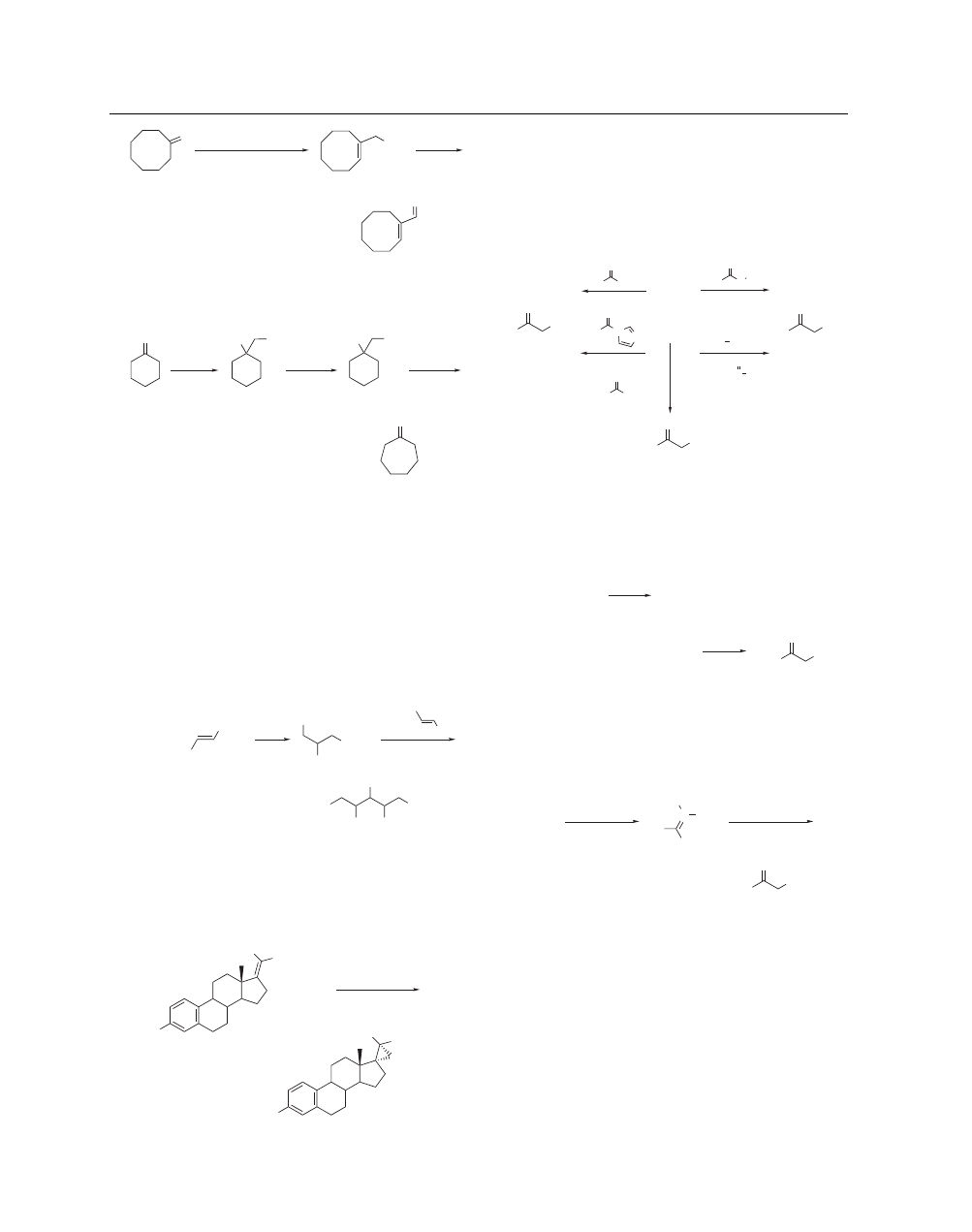
NITROMETHANE
1
Nitromethane
MeNO
2
[75-52-5]
CH
3
NO
2
(MW 61.05)
InChI = 1/CH3NO2/c1-2(3)4/h1H3
InChIKey = LYGJENNIWJXYER-UHFFFAOYAW
(building block in synthesis; polar solvent)
Physical Data:
mp −28.5
◦
C; bp 101
◦
C; d 1.13 g cm
−3
; dipole
moment 3.5 D.
Solubility:
completely misc most organic solvents; slightly sol
petroleum ether, water; sol alkaline solution.
Form Supplied in:
colorless liquid, widely available.
Purification:
purified by drying over MgSO
4
and distilling; a
small acidic forerun is discarded.
Handling, Storage, and Precautions:
stable compound. It is ad-
vised not to distill large quantities at reduced pressure. Flamm-
able; toxic. Gives shock- and heat-sensitive alkali and heavy
metal salts. Do not dry the sodium salt.
Introduction. Nitromethane is a common starting material
for the synthesis of aliphatic nitro compounds, which serve as
valuable building blocks, providing access to a variety of other
functionalized products such as 2-nitro alcohols, nitroalkanes,
nitroalkenes, hydrocarbons, amines, oximes, carbonyl com-
pounds, and heterocycles.
1
Nitromethane reacts with alkali metal
hydroxides and alkoxides to form the metal nitronates which are
used as in situ generated reagents. The alkali metal nitronates are
unstable and it is advisable not to isolate them. The sodium salt of
nitromethane undergoes violent decomposition or detonation on
heating and drying.
The Nitroaldol Reaction (Henry Reaction).
2
Reactions with Aldehydes.
In the presence of base, nitro-
methane reacts with aliphatic aldehydes in an aldol-type reaction
with formation of 2-nitro alcohols (nitroaldols). Due to its re-
versibility, the reaction is normally carried out in the presence of
only catalytic quantities of base, although in certain cases stoichio-
metric amounts are used to precipitate the product.
3
The reaction
of nitromethane with aldehydes in the presence of one equiva-
lent of base gives the salt of the aci-nitro tautomer of the product,
which must be carefully acidified to avoid the Nef reaction. Alkali
metal hydroxides, alkoxides or carbonates, and tertiary amines are
effective catalysts.
2a
Elimination of water, the aldol reaction, and
the Cannizzaro reaction are competing side reactions.
2a,b
2-Nitro
alcohols are unstable compounds and care has to be exercised
during workup (decomposition during distillation). Fluoride ion
catalysts often give higher yields.
4
The reaction has been carried
out in the absence of solvent using powdered NaOH,
5
Al
2
O
3
,
6
and
Al
2
O
3
-supported KF
7
as catalysts. The 2-nitro alcohols are readily
converted into a variety of functionalities (eq 1).
1b,4,5,7
–
13,16
–
21
Aromatic aldehydes react smoothly with nitromethane
under the same conditions.
14
Elimination of water to give
β
-nitrostyrenes takes place on acidification.
2a
Synthesis of
β
-nitrostyrenes can be accomplished in one step by heating aro-
matic aldehydes in acetic acid and with NH
4
OAc as catalyst.
15
Dehydration of 2-nitro alcohols to nitroalkenes has been accom-
plished with Methanesulfonyl Chloride,
16
phthalic anhydride,
17
1,3-Dicyclohexylcarbodiimide,
18
pivaloyl chloride,
19
Trifluo-
roacetic Anhydride,
20
and Acetic Anhydride.
20
Heating 2-nitro
alcohols in dichloromethane in the presence of basic aluminium
oxide is another mild method for the synthesis of nitro alkenes.
21
Nitroalkenes can be converted into a variety of functionalities
(eq 2)
2,5,22,24
–
30
and have found utility as heterodienes in hetero
Diels–Alder reactions and as reactants in Lewis acid promoted
tandem [4 + 2]/[3 + 2] cycloadditions.
23
R
NO
2
OH
R
NO
2
R
NO
2
R
NO
2
O
R
NH
2
OH
R
O
R
NH
2
R
O
R
CN
(1)
R
O
R
NOH
R
NHOH
R
OAc
R
′
R
NH
2
R
NO
2
R
′
NO
2
R
R
′
R
NO
2
R
NO
2
Nu
R
NO
2
R
′
(2)
A catalytic asymmetric nitroaldol reaction has been dev-
eloped.
31
The catalyst is formed from Lanthanum(III)
Chloride, the dilithium salt of (R)-1,1
′
-Bi-2,2
′
-naphthol, NaOH,
and H
2
O in a 1:1:1:10 molar ratio in THF. Nitromethane reacts
with various aldehydes in the presence of 10% of the catalyst
to give 2-nitro alcohols in high yields and with an ee as high
as 93% (eq 3). Chiral binaphthol complexes of other rare earth
metal trichlorides show similar catalytic effects. The optical puri-
ties of nitroaldols obtained using these rare earth metal complexes
as asymmetric catalysts are highly dependent on the amount of
water present and on the relation between substrate and radius of
the rare earth metals.
O
CHO
MeO
O
MeO
NO
2
OH
(3)
MeNO
2
, –50 °C
10% BINOL–La complex
93% ee
76%
Nitromethane can react with two mol equiv of an aldehyde.
2a
The reaction with the second aldehyde molecule proceeds slower
Avoid Skin Contact with All Reagents

2
NITROMETHANE
than that with the first due to the lower acidity of the α-proton
in 2-nitro alcohols and enhanced steric hindrance. With steri-
cally hindered aldehydes, the reaction with the second aldehyde
is difficult.
2b,d
Seebach et al.
32
synthesized the multiple coupling
reagent 2-nitro-2-propenyl 2,2-dimethylpropanoate (NNP) from
nitromethane. In the initial step, nitromethane reacts with two
moles of formaldehyde to give 1,3-dihydroxy-2-nitropropane in
95% yield. Subsequent acylation with two mol equiv of pivaloyl
chloride and elimination of pivalic acid gives NNP. The reaction
may be run on a 40 to 200 g scale without problems (eq 4). NNP
allows succesive introduction of two different nucleophiles Nu
1
and Nu
2
(eq 5).
NO
2
Na
CH
2
HO
OH
NO
2
Na
HO
OH
NO
2
(4)
O
O
NO
2
2 CH
2
O
+
t
-Bu
t
-Bu
O
O
O
NO
2
t
-Bu
O
MeOH
H
+
t
-BuCOCl, CH
2
Cl
2
NaOAc
Et
2
O
NNP
95%
75%
45%
95%
(5)
+
Nu
1
O
NO
2
t
-Bu
O
Nu
2
N
O
–
–
O
NO
2
Nu
1
NO
2
Nu
1
Nu
2
Nu
1
O
t
-Bu
O
With dialdehydes, nitromethane forms cyclic nitro com-
pounds.
33
Nitromethane reacts with glyoxal at pH 10 to give a
mixture of isomeric inositol derivatives from which neo-inositol,
one of 14 possible diastereomers, precipitates (72% yield) (eq 6).
(6)
O
O
O
2
N
OH OH
NO
2
OH
OH
2
+
2 MeNO
2
pH 10
72%
Tartaraldehyde gives a mixture of stereomeric nitro-2,3,4,5-
cyclopentanetetraols.
33
With o-phthalaldehydes, nitromethane re-
acts in alcoholic alkali to give, after acidification, 2-nitro-3-hydro-
xyindenes.
33
Dialdehydes derived from periodate cleavage of
sugars react with nitromethane in a one-pot cyclization reaction
to give, frequently, one predominant stereoisomer (eq 7).
33,34
1. MeNO
2
, NaOMe
O
O
O
Ph
O
2
N
OH
O
HO
HO
HO
HO
OHC
OHC
O
HO
(7)
NaIO
4
2. H
+
3. PhCHO
meso
-1,5-Dialdehydes react with nitromethane in methanol
and a catalytic amount of NaOH to give a crude mixture of
2,6-dihydroxynitrocyclohexanes from with the major trans,trans-
isomer precipitates (eq 8).
35
The diacetates of carbocyclic and
heterocyclic six-membered compounds formed by this reaction
can be saponified enantioselectively with pig liver esterase (PLE)
to give monoacetates of >95% ee.
35
(8)
OHC
X
CHO
X
OH
NO
2
X
AcO
OAc
NO
2
X
HO
OAc
NO
2
+
MeNO
2
1. HO
–
PLE
HO
>95% ee
X = CH
2
, CHMe, CHOEt, O, S
Ac
2
O
2. H
+
H
+
In the presence of primary or secondary amines, aldehydes react
with nitromethane in a Mannich-type reaction.
2d
Reactions with Ketones.
Unlike other nitroalkanes, nitro-
methane often gives satisfactory yields in the reaction with
ketones.
2b
The reaction is complex and depends on the ratio of
reactants, base, temperature, and time (eq 9).
2a
(9)
NO
2
O
O
2
N
NO
2
O
OH
NO
2
NO
2
O
+
MeNO
2
MeNO
2
With alkali metal hydroxides or alkoxides, quaternary am-
monium hydroxides, primary or tertiary amines, or Tetrabutyl-
ammonium Fluoride under pressure
36
it is usually possible to
stop the reaction at the nitro alcohol stage.
2d
When the reaction is
catalyzed by secondary amines, nitroalkenes are isolated.
37
From
3β-hydroxyandrost-5-en-17-one, nitromethane, and 1% 1,2-Di-
aminoethane as catalyst, an exocyclic nitroalkene is obtained
(eq 10),
38
although exocyclic nitroalkenes often rearrange to the
endocyclic β,γ-nitroalkenes. With N,N-dimethylethylenediamine
as base, it is possible to selectively synthesize allylic nitro com-
pounds from both acyclic and alicyclic ketones (eq 11).
39
(10)
NO
2
H
HO
O
HO
MeNO
2
1% H
2
NCH
2
CH
2
NH
2
95%
A list of General Abbreviations appears on the front Endpapers

NITROMETHANE
3
(11)
O
NO
2
O
30% H
2
NCH
2
CH
2
NMe
2
1. NaOH
benzene, reflux
2. TiCl
3
Nitromethane has been used in the Tiffeneau–Demjanov ring
expansion of cyclic ketones by reduction of the nitro alcohol to
the β-hydroxy amine and diazotization (eq 12).
40
(12)
O
O
HO
NO
2
HO
NH
2
MeNO
2
H
2
NaNO
2
base
Raney Ni
MeCO
2
H
Michael Reactions. Conjugate addition of nitromethane to
activated double bonds is another important C–C bond forming
reaction (eq 13). Unsaturated aldehydes give rise to competing 1,2-
addition (Henry reaction), which can be controlled to some extent
by the choice of catalyst.
2a
Michael additions with nitromethane
are catalyzed in homogeneous solution with catalysts such as
alkali metal hydroxides in alcohol,
41
organic nitrogen bases,
42
and fluoride ions.
43
The reaction is also catalyzed in heteroge-
neous systems with alumina
44
or Al
2
O
3
-supported KF or CsF.
45
Nitromethane reacts smoothly with two moles of Michael accep-
tors to give a variety of coupling products (eq 13).
43,44
R
′
EWG
′
NO
2
EWG
′
R
′
R
′′
EWG
′′
NO
2
EWG
′
R
′
EWG
′′
R
′′
MeNO
2
+
(13)
base
EWG = CHO, COR, CO
2
R, CN, SOR, SO
2
R, NO
2
Nitromethane has been employed in cyclopropanation.
46
The
product is formed by Michael addition of nitromethane to a double
bond with two geminal electron withdrawing groups followed by
elimination of the nitro group (eq 14).
(14)
MeO
CO
2
Me
NC
MeO
CO
2
Me
NC
MeNO
2
, MeONa
MeOH
85%
Acylation of Nitromethane.
With few exceptions, acyla-
tion of sodium methanenitronate with acyl halides or anhydrides
occurs on oxygen. The unstable products rearrange into hydrox-
amic acid derivatives. C-Acylation can be accomplished with
acylimidazoles,
47
acyl cyanide,
48
and phenyl benzoates
49
and
from benzoic acids by the action of Diethyl Phosphorocyanidate
(eq 15).
50
CN
O
R
N
R
R
O
N
O
NO
2
MeO
O
OMgOMe
MeO
O
NO
2
Ar
O
O
Ar CO
2
H
(EtO)
2
P
O
CN
Ar
O
NO
2
(15)
Ph
MeNO
2
Carboxylation can be accomplished by reaction with methoxy-
magnesium methyl carbonate (Stiles reagent).
51
Another method
for the preparation of methyl 2-nitroacetate is by heating
nitromethane at 160
◦
C in the presence of KOH, followed by acid-
ification of the nitronate salt at −15
◦
C in the methanolic solution
(eq 16).
52
(16)
–15 °C
2 MeNO
2
+
KOH
MeO
NO
2
O
160 °C
KO
2
N=CHCO
2
K
+
H
2
SO
4
+
MeOH
KO
2
N=CHCO
2
K
+
NH
3
+
2 H
2
O
The dilithium salt of nitromethane reacts with carboxylic esters
at −30
◦
C to form the β-oxo nitronate, which must be carefully
acidified at −90
◦
C with acetic acid (eq 17).
53
The dilithium salt of
nitromethane is formed by treatment of nitromethane with Butyl-
lithium in THF/HMPA at −65
◦
C.
53
The dilithium salt is a much
harder carbon nucleophile than the sodium nitronate.
Ph
NO
2
O
LiO
N
Li
O
–
1. PhCO
2
Me
–78 to –30 °C
(17)
THF, HMPA
BuLi
H
+
MeNO
2
2. AcOH, –90 °C
–90 to –65 °C
Alkylation of Nitromethane.
The ambident methanenitro-
nate ion reacts with alkyl iodides to give a mixture of C-alkylated
and primarily O-alkylated compounds. The alkyl nitronates of
nitromethane are very unstable and decompose to carbonyl com-
pounds and formaldoxime.
54
The sodium salt of nitromethane can
be selectively C-benzylated with 1-benzyl-2,4,6-triphenylpyridi-
nium tetrafluoroborate in good to moderate yields.
55
The pyri-
dinium cations are readily available from 2,4,6-Triphenylpyry-
lium Tetrafluoroborate and the corresponding benzylamines.
55
The dilithium salt of nitromethane is C-alkylated with 1-iodo-
hexane in moderate yield.
56
Kornblum et al. has reported on a
general high yielding method for the C-alkylation of nitromethane
Avoid Skin Contact with All Reagents

4
NITROMETHANE
with tertiary nitro compounds (eq 18).
57
The tertiary nitro group is
substituted with nitromethane in a radical chain process. The reac-
tion is carried out at 25
◦
C in DMSO with exposure to fluorescent
light and the molar ratio of tertiary nitro compound, nitromethane,
and NaH is 1:4:8.
(18)
CN
NO
2
CN
NO
2
CN
O
MeNO
2
, NaH
Me
2
SO, 25 °C
t
-BuONa
t
-BuOH
KMnO
4
91%
81%
1,3-Dipolar Cycloadditions of Nitromethane. Nitromethane
can be O-silylated with Chlorotrimethylsilane in the presence of
Triethylamine.
58a
The trimethylsilyl methanenitronate is unstable
and dimerizes, but it can be trapped with an activated alkene in a
1,3-dipolar cycloaddition to give isoxazolidines which, upon acid
treatment, give isoxazolines (eq 19).
58
N
+
O
–
N
TMSO
OTMS
OH
CN
Et
3
N
H
2
C N
+
O
–
OTMS
O
N
TMSCl
Et
3
N
H
+
MeNO
2
OTMS
O
N
(19)
In contrast to other primary nitro compounds, the correspond-
ing nitrile oxide (fulminic acid) of nitromethane is not formed
in the Mukaiyama reaction.
59
When nitromethane is treated with
Phenyl Isocyanate, α-nitroacetanilide is formed first and is subse-
quently transformed to the nitrile oxide with a second mol equiv of
phenyl isocyanate (eq 20). The nitrile oxide reacts with terminal
double bonds in a regioselective manner to give 3,5-substituted
isoxazolines.
59
PhNH
NO
2
O
O
N
R
(20)
PhNH
C
O
N O
–
Ph–N=C=O
MeNO
2
+
Ph–N=C=O
+
R
O
NHPh
Related Reagents. t-Butyldimethylsilyl Ethylnitronate; Li-
thium α-Lithiomethanenitronate; O,O-Dilithio-1-nitropropene;
Nitroethane; 1-Nitropropane; 1-Nitro-1-propene.
1.
(a) Seebach, D.; Colvin, E. W.; Lehr, F.; Weller, H., Chimia 1979, 33, 1.
(b) Rosini, G.; Ballini, R., Synthesis 1988, 833.
2.
(a) v. Schickh, O.; Apel, G.; Padeken, H. G.; Schwarz, H. H.; Segnitz,
A., Methoden Org. Chem. (Honben-Weyl) 1971, 10/1(b) Rosini, G.,
Comprehensive Organic Synthesis 1991
, 2, 321. (c) Jones, G., Org. React.
1967, 15, 204. (d) Baer, H. H.; Urbas, L. In The Chemistry of the Nitro
and Nitroso Groups
; Feuer, H., Ed.; Wiley: New York, 1970; Part 2,
p 75. (e) Hass, H. B.; Riley, E. F., C. R. Hebd. Seances Acad. Sci. 1943,
32
, 373.
3.
(a) Dauben, H. J. Jr.; Ringold, H. J.; Wade, R. H.; Pearson, D. L.;
Anderson; A. G., Jr.; Org. Synth., Coll. Vol. 1963, 4, 221. (b) Noland, W.
E., Org. Synth., Coll. Vol. 1973, 5, 833.
4.
Wollenberg, R. H.; Miller, S. J., Tetrahedron Lett. 1978, 3219.
5.
Bachman, G. B.; Maleski, R. J., J. Org. Chem. 1972, 37, 2810.
6.
(a) Rosini, G.; Ballini, R.; Petrini, M.; Sorrenti, P., Synthesis 1985, 515.
(b) Rosini, G.; Ballini, R.; Sorrenti, P., Synthesis 1983, 1014.
7.
Melot, J.-M.; Texier-Boullet, F.; Foucaud, A., Tetrahedron Lett. 1986,
27
, 493.
8.
Colvin, E. W.; Seebach, D., J. Chem. Soc., Chem. Commun. 1978, 689.
9.
(a) Noland, W. E., C. R. Hebd. Seances Acad. Sci. 1955, 55, 137.
(b) Ballini, R.; Petrini, M., Tetrahedron Lett. 1989, 30, 5329. (c) Clark,
J. H.; Cork, D. G.; Gibbs, H. W., J. Chem. Soc., Perkin Trans. 1 1983,
2253.
10.
Petrini, M.; Ballini, R.; Rosini, G., Synthesis 1987, 713.
11.
Wehrli, P. A.; Schaer, B., J. Org. Chem. 1977, 42, 3956.
12.
Rosini, G.; Ballini, R.; Sorrenti, P.; Petrini, M., Synthesis 1984, 607.
13.
Ono, N.; Kaji, A., Synthesis, 1986, 693.
14.
(a) Worrall, D. E., Org. Synth., Coll. Vol. 1956, 1, 405. (b) Schales, O.;
Graefe, H. A., J. Am. Chem. Soc. 1952, 74, 4486.
15.
Raiford, L. C.; Fox, D. E., J. Org. Chem. 1944, 9, 170.
16.
Melton, J.; McMurry, J. E., J. Org. Chem. 1975, 40, 2138.
17.
Buckley, G. D.; Scaife, C. W., J. Chem. Soc. 1947, 1471.
18.
Knochel, P.; Seebach, D., Synthesis 1982, 1017.
19.
Knochel, P.; Seebach, D., Tetrahedron Lett. 1982, 23, 3897.
20.
Denmark, S. E.; Moon, Y.-C.; Cramer, C. J.; Dappen, M. S.; Senanayake,
C. B. W., Tetrahedron 1990, 46, 7373.
21.
Ballini, R.; Castagnani, R.; Petrini, M., J. Org. Chem. 1992, 57, 2160.
22.
(a) Barrett, A. G.; Graboski, G. G., C. R. Hebd. Seances Acad. Sci. 1986,
86
, 751. (b) Posner, G. H.; Crouch, R. D., Tetrahedron 1990, 46, 7509.
23.
(a) Denmark, S. E.; Senanayake, C. B. W.; Ho, G.-D., Tetrahedron 1990,
46
, 4857. (b) Denmark, S. E.; Senanayake, C. B. W., J. Org. Chem. 1993,
58
, 1853.
24.
Denmark, S. E.; Marcin, L. R., J. Org. Chem. 1993, 58, 3850.
25.
(a) Kabalka, G. W.; Guindi, L. H. M., Tetrahedron 1990, 46, 7443.
(b) Rylander, P. Catalytic Hydrogenation in Organic Synthesis;
Academic: New York, 1979. (c) Erne, M.; Ramirez, F., Helv. Chim. Acta
1950, 33, 912.
26.
Aizpurua, J. M.; Oiarbide, M.; Palomo, C., Tetrahedron Lett. 1987, 28,
5365.
27.
Torii, S.; Tanaka, H.; Katoh, T., Chem. Lett. 1983, 607.
28.
Varma, R. S.; Varma, M.; Kabalka, G. W., Tetrahedron Lett. 1985, 26,
3777.
29.
Ono, N.; Kamimura, A.; Kaji, A., Tetrahedron Lett. 1984, 25, 5319.
30.
(a) Ono, N.; Miyake, H.; Kaji, A., J. Chem. Soc., Chem. Commun. 1982,
33. (b) Enders, D.; Meyer, O.; Raabe, G., Synthesis 1992, 1242.
31.
(a) Sasai, H.; Suzuki, T.; Arai, S.; Arai, T.; Shibasaki, M., J. Am. Chem.
Soc. 1992
, 114, 4418. (b) Sasai, H.; Suzuki, T.; Itoh, N.; Shibasaki, M.,
Tetrahedron Lett. 1993
, 34, 851. (c) Sasai, H.; Suzuki, T.; Itoh, N.; Arai,
S.; Shibasaki, M., Tetrahedron Lett. 1993, 34, 2657.
32.
Seebach, D.; Knochel, P., Helv. Chim. Acta 1984, 67, 261.
33.
Lichtenthaler, F. W., Angew. Chem., Int. Ed. Engl. 1964, 3, 211.
34.
(a) Wade, P. A.; Giuliano, R. M. In Nitro Compounds; Feuer, H.; Nielsen,
A. T., Eds.; VCH: New York, 1990; p 137. (b) Sakakibara, T.; Nomura,
Y.; Sudoh, R., Carbohydr. Res. 1983, 124, 53. (c) Fujimaki, I.; Kuzuhara,
H., J. Carbohydr. Chem. 1982, 1, 145.
35.
Eberle, M.; Egli, M.; Seebach, D., Helv. Chim. Acta 1988, 71, 1.
A list of General Abbreviations appears on the front Endpapers

NITROMETHANE
5
36.
Matsumoto, K., Angew. Chem., 1984 96, 599.
37.
Ho, T.-L.; Wong, C. M., Synthesis 1974, 196.
38.
Barton, D. H. R.; Motherwell, W. B.; Zard, S. Z., Bull. Soc. Chem. Fr.,
Part 2 1983
, 61.
39.
Tamura, R.; Sato, M.; Oda, D., J. Org. Chem. 1986, 51, 4368.
40.
Dauben, H. J.; Ringold, H. J.; Wade, R. H.; Pearson, D. L.; Anderson,
A. G., Org. Synth., Coll. Vol. 1963, 4, 221; Smith, P. A. S.; Baer, D. R.,
Org. React. 1960
, 11, 157.
41.
Asaoka, M.; Mukuta, T.; Takei, H., Tetrahedron Lett. 1981, 22, 725.
42.
(a) Bäckvall, J.-E.; Ericsson, A. M.; Plobeck, N. A.; Juntunen, S. K.,
Tetrahedron Lett. 1992
, 33, 131. (b) Ono, N.; Kamimura, A.; Miyake,
H.; Hamamoto, I.; Kaji, A., J. Org. Chem. 1985, 59, 3692. (c) Ono, N.;
Kamimura, A.; Kaji, A., Synthesis 1984, 226.
43.
(a) Anderson, D. A.; Hwu, J. R., J. Org. Chem. 1990, 55, 511.
(b) Anderson, D. A.; Hwu, J. R., J. Chem. Soc., Perkin Trans. 1 1989,
1694. (c) Clark, J. H.; Miller, J. M.; So, K. H., J. Chem. Soc., Perkin Trans.
1 1978
, 941. (d) Colonna, S.; Hiemstra, H.; Wynberg, H., J. Chem. Soc.,
Perkin Trans. 1 1978
, 238. (e) Belsky, I., J. Chem. Soc., Chem. Commun.
1977, 237.
44.
Rosini, G.; Ballini, R.; Petrini, M.; Marotta. E., Angew. Chem. 1986, 98,
935
45.
(a) Bergbreiter, D. E.; Lalonde, J. J., J. Org. Chem. 1987, 52, 1601.
(b) Clark, J. H.; Cork, D. G.; Robertson, M. S., Chem. Lett. 1983, 1145.
46.
Annen, K.; Hofmeister, H; Laurent, H.; Seeger, A.; Wiechert, R., Chem.
Ber. 1978
, 111, 3094.
47.
(a) Baker, D. C.; Putt, S. R., Synthesis 1978, 478. (b) Crumbie, R. L.;
Nimitz, J. S.; Mosher, H. S., J. Org. Chem. 1982, 47, 4040.
48.
Bachman, G. B.; Hokama, T., J. Am. Chem. Soc. 1959, 81, 4882.
49.
Field, G. F.; Zally, W. J., Synthesis 1979, 295.
50.
Hamada, Y.; Ando, K.; Shioiri, T., Chem. Pharm. Bull. 1981, 29, 259.
51.
Stiles, M.; Finkbeiner, H. L., J. Am. Chem. Soc. 1959, 81, 505.
52.
Zen, S.; Koyama, M.; Koto, S., Org. Synth., Coll. Vol. 1988, 6, 797.
53.
Lehr, F.; Gonnermann, J.; Seebach, D., Helv. Chim. Acta 1979, 62, 2258.
54.
(a) Kerber, R. C.; Urry, G. W.; Kornblum, N., J. Am. Chem. Soc. 1965,
87
, 4520. (b) Kornblum, N.; Brown, R. A., J. Am. Chem. Soc. 1964,
86
, 2681. (c) Kornblum, N.; Brown, R. A., J. Am. Chem. Soc. 1963, 85,
1359.
55.
Katritzky, A. R.; De Ville, G.; Patel, R. C., J. Chem. Soc., Chem.
Commun. 1979
, 602.
56.
Seebach, D.; Henning, R.; Lehr, F.; Gonnermann, J., Tetrahedron Lett.
1977, 1161.
57.
Kornblum, H.; Erickson, A. S., J. Org. Chem. 1981, 46, 1037.
58.
(a) Torssell, K. B. G.; Zeuthen, O., Acta Chem. Scand. 1978, B32, 118.
(b) Das, N. B.; Torssell, K. B. G., Tetrahedron 1983, 39, 2247.
59.
(a) Mukaiyama, T.; Hoshino, T J. Am. Chem. Soc. 1960, 82, 5339.
(b) Paul, R.; Tchelitcheff, S., Bull. Soc. Chem. Fr. 1963, 140.
Kurt B. G. Torssell & Kurt. V. Gothelf
Aarhus University, Aarhus, Denmark
Avoid Skin Contact with All Reagents
Wyszukiwarka
Podobne podstrony:
benzyl chloride eros rb050
hydrobromic acid eros rh031
chloroform eros rc105
magnesium eros rm001
oxalyl chloride eros ro015
potassium permanganate eros rp244
peracetic acid eros rp034
p toluenesulfonic acid eros rt134
hexamethylenetetramine eros rh019
copper II chloride eros rc214
glyoxylic acid eros rg009
p methoxybenzaldehyde eros rm081
Rozdział V Eros
Eros i Tanatos
0844 fuego en el fuego eros ramazzotti XSLM5TN7TUAX4Y72WS55YKTPIHYGXX5ZORKV6YA
oxygen eros ro028
lithium chloride eros rl076
więcej podobnych podstron